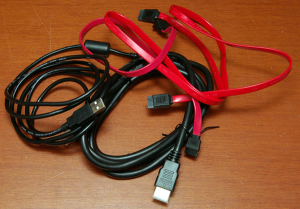 Have you every been inside an electronics store buying a new HDTV, Blu-ray player or home theater equipment when you are told that you should pick up some premium cables to ensure the best experience possible? Often times these premium cables are placed prominently near the equipment and checkout lines to try and entice buyers to pick them up. Don’t be fooled, most of these cables are there for a single purpose, high profit margins. It is rare that any of these cables will make a single bit of difference in the performance of your video or audio so its best not to spend the money.
Have you every been inside an electronics store buying a new HDTV, Blu-ray player or home theater equipment when you are told that you should pick up some premium cables to ensure the best experience possible? Often times these premium cables are placed prominently near the equipment and checkout lines to try and entice buyers to pick them up. Don’t be fooled, most of these cables are there for a single purpose, high profit margins. It is rare that any of these cables will make a single bit of difference in the performance of your video or audio so its best not to spend the money.
Digital Changed Everything
Previously, audio and video were sent using analog signals rather than digital. Analog signals are a bit more forgiving than digital signals which means that you will still hear sound or see the picture but it might be distorted slightly. Now most all A/V signals are done digitally. This is a much more efficient means of sending a signal but it also means that it either works or it does not at all. There is little room for signal errors.
Back to the issue of premium cables. These cables generally have thicker wiring, higher conductive metals that don’t corrode, magnets for attempting to filter the signal for noise, etc. These features were useful to try and keep the signal as clean as possible when it was an analog signal but with digital it is a bit less of a requirement. It especially is not necessary if you are using an optical cable like a SPD/IF or TOSLink for audio. With the short distances that are generally used in consumer electronics, these features tend to not lend any benefit to the user experience. Thus, why pay $30 to $40 for an HDMI cable when a simple $10 cable will work just fine? This is precisely why companies such as are able to sell cables a much more affordable prices that work just fine.
Sometimes Premium Cables Do Matter
While I think most consumers won’t see any benefit to their experience by spending more for cables, there are some instances where premium cables do matter. Specifically, there are two instances, distance and features.
The longer that a cable is, the greater potential there is for a cable to introduce enough noise into the signal that it won’t work. As consumers, we generally do not see this problem as we only have to run a cable maybe ten to twenty feet. But say you need to run a signal over a cable for 100 feet? This is a situation where a premium cable may actually make a difference. Of course the cost for such cables is generally very high such that you want to make absolutely sure it is a situation that will require the cable before you spend the money.
When I talk about features, I’m generally referring to attributes outside of the carrying of the signal on the cable. This can be things like special connectors or even the sleeve of the cable. For instance, I used some premium speaker wire for running my speaker cables. I did this because my older home doesn’t allow me to run the wiring internally through the walls to my ceiling mounted speakers. So I used a flat cable with a sleeve that could be painted to best hide the cabling. Similarly, you can get cables with adjustable connectors to make it easier to plug into your equipment at those odd angles.
Super Cheap Cables Can Be A Problem Too
Of course the other side of the spectrum can be just as annoying. While premium cables may end up costing a lot, they generally don’t fail and if they do they have some solid warranties behind them. Super cheap cables can also be a problem. For instance, my wife bought two generic 10-foot long USB to Apple 30-pin dock cables for around $4/each. While they worked OK for short while, both cables now fail to reliably charge our devices in less than two months. Why? The connectors or wires are coming loose inside of the cable. So beware of the super cheap cables as well.
Another cable I would avoid going super cheap with is USB Type C cables. These are designed to carry power to devices, some of them extremely expensive like the MacBook and Google Pixel. Many of the extremely inexpensive cables are not properly designed to carry the power and can result in damage to your devices. If you plan on using a USB Type C to power a device, I recommend spending a bit and researching to make sure it is safe rather than spending less but ending up destroying your expensive device.

I appreciate you explaining when to use premium cables. I never get them for use in my home, because I figure it doesn’t matter too much. I’m really glad that it doesn’t. However, I know that my company uses higher quality cables. Probably for the reason you explained, because they are longer. My company also needs the cables to work as efficiently as possible. In any case, it is nice to know why and when to get better cables so that I don’t waste my money.